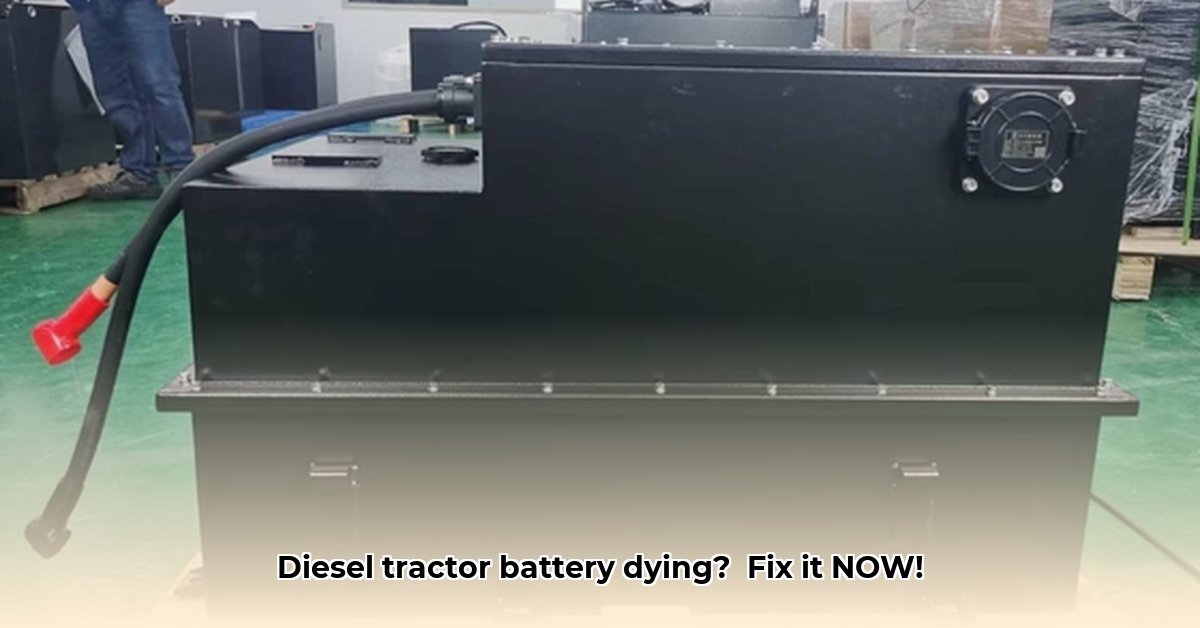
Battery for Diesel Tractor: Powering Up Your Farm's Efficiency
Modern farming demands reliable equipment. A dependable tractor battery is crucial. A dead battery means costly downtime. This guide helps you choose and maintain the right battery for smooth operation. For more information on tractor battery charging, see this helpful resource: Learn More.
Understanding Your Diesel Tractor's Battery Needs
Diesel tractors need powerful batteries to start their engines. You'll typically find deep-cycle lead-acid batteries. Unlike car batteries (designed for short bursts of power), these handle repeated charging and discharging. Three main types exist: flooded, gel-cell, and AGM (Absorbent Glass Mat).
| Battery Type | Advantages | Disadvantages | Best For |
|---|---|---|---|
| Flooded | Generally cheapest; widely available. | Requires regular maintenance (water level checks); prone to leaks. | Budget-conscious farmers with time for maintenance |
| Gel-Cell | Maintenance-free; spill-proof. | More expensive than flooded; slightly lower capacity. | Farmers prioritizing low maintenance and willing to pay slightly more. |
| AGM (Absorbent Glass Mat) | Maintenance-free; spill-proof; vibration-resistant. | Most expensive; susceptible to overcharging damage. | Farmers prioritizing longevity, reliability, and durability in tough conditions. |
The best choice depends on your budget and maintenance preferences. For a "set it and forget it" approach, AGM or gel-cell batteries are worth the higher initial cost, offering extended lifespan and reduced maintenance.
Picking the Perfect Battery for Your Tractor
Choosing correctly is crucial. Don't settle for just any battery; consider these factors:
- Cold Cranking Amps (CCA): Indicates starting power in cold temperatures. Higher CCA is better for cold climates.
- Reserve Capacity (RC): Shows how long the battery powers accessories (lights, radio) with the engine off. Higher RC is useful for frequent accessory use.
- Group Size: The battery's physical dimensions. Ensure it fits your tractor's battery tray.
- Voltage: Most tractors use 12 volts, but check your tractor's manual. Incorrect voltage damages your equipment.
Important: Your tractor's owner's manual is essential! It provides specific battery recommendations. Using an incompatible battery can damage your equipment.
Keeping Your Tractor's Battery in Tip-Top Shape
Preventative maintenance extends battery life and ensures reliable starts.
Step-by-Step Battery Maintenance:
- Clean Terminals: Regularly clean corrosion from battery terminals using a wire brush and baking soda paste (baking soda mixed with water). Corrosion hinders electrical flow.
- Check Fluid Levels (Flooded Batteries ONLY): For flooded batteries, check the water level. Add distilled water (not tap water) to cover the plates.
- Inspect Cables: Check battery cables for cracks, fraying, or loose connections. Replace damaged cables promptly.
- Avoid Deep Discharging: Avoid fully draining the battery. Allow full recharging after each use. Deep discharging drastically shortens lifespan.
- Regular Charging (Especially for infrequent use): For tractors in extended idle periods, use a battery charger to maintain charge and prevent sulfation (a battery-damaging process).
Regular checks prevent surprises and increase battery longevity, saving money. Isn't preventing costly repairs a worthwhile investment of your time?
The Environmental and Economic Benefits of a Good Battery
A high-quality battery is more than just avoiding breakdowns; it's an investment in farm efficiency and environmental responsibility. Reliable power means less downtime, reducing fuel consumption and emissions. A well-maintained battery extends your tractor’s life and minimizes your environmental impact. It benefits your wallet and the planet!
How to Secure Government Subsidies for Sustainable Farming Practices
Key Takeaways:
- Upgrading your diesel tractor's battery boosts efficiency and lowers emissions, aligning with sustainable farming goals.
- Government subsidies support sustainable agricultural practices, including equipment efficiency improvements.
- Effectively documenting your investments is crucial for securing subsidies.
- Improved fuel economy from a better battery leads to direct cost savings.
- Sustainable farming practices are increasingly valued by consumers, positively impacting market access.
Why a New Diesel Tractor Battery Matters for Subsidies
Upgrading your battery isn't merely about preventing breakdowns; it's about sustainability and potentially accessing government funding. A modern battery improves fuel economy. Less fuel means lower emissions—a key factor in many subsidy programs. A strong, reliable battery is a long-term investment in your operation's health, attracting attention from funding programs.
Understanding the Subsidy Landscape
Navigating agricultural subsidies can seem daunting, but it isn't. Many government agencies offer incentives for farmers adopting eco-friendly technologies. These programs vary regionally; research local and national opportunities. Search for keywords like "sustainable agriculture," "renewable energy," "fuel efficiency," and "emission reduction" to find suitable programs. Your battery upgrade fits into several of these categories, particularly fuel efficiency and reduced emissions.
Documenting Your Investment
Meticulous record-keeping helps secure subsidies. Keep detailed records: purchase receipts, maintenance logs, and fuel consumption data (before and after the upgrade). Quantify improvements—show your fuel savings and cost reductions. A well-organized system greatly simplifies the application process.
Finding the Right Battery for Your Needs
Battery quality matters. Consider these factors:
- Amperage (Ah): Higher amperage usually means more cranking power and longer lifespan.
- Cold Cranking Amps (CCA): Crucial for reliable cold-weather starting.
- Maintenance Requirements: Opt for low-maintenance or maintenance-free options for simpler upkeep.
- Size and Fit: Ensure the battery fits your tractor's tray.
A high-quality battery means less downtime and increased productivity—arguments that resonate with subsidy evaluators.
The Sustainability Connection
Investing in a high-performance battery supports sustainable farming. Improved fuel efficiency reduces your carbon footprint, aligning with government initiatives and attracting environmentally-conscious consumers. It makes your farm more appealing and strengthens your subsidy application.
[1] https://www.usda.gov/farming-and-ranching/resources-small-and-mid-sized-farmers/programs-and-support-small-and-mid-sized-farmers